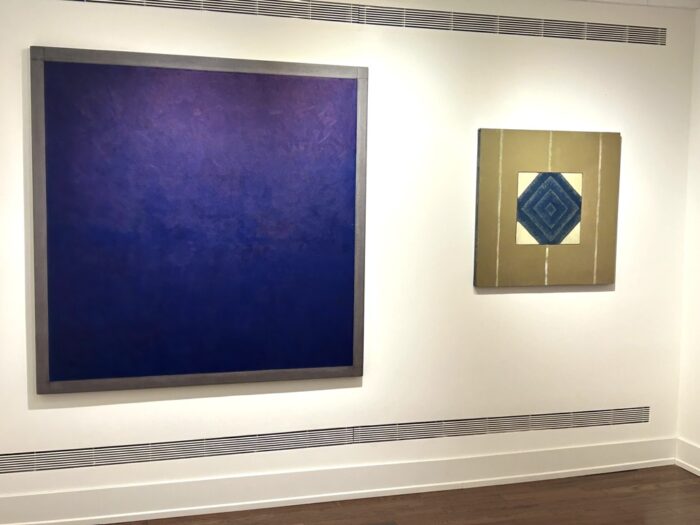
A new exhibit at The National Arts Club (January 8-February 2) presents the work of Thor Rinden, a Brooklyn-based artist who died in 2009. The artist, who moved from Iowa to New York in the late 1960’s developed a style that emerged from hybrid influences: a Midwest childhood and the vital New York art scene he encountered in Manhattan during the ensuing decades. The outcome of these dual influences, as demonstrated in this disarmingly beautiful retrospective, is a body of highly original work, abstract and figurative, hard-edged, and soft-focused that reflects the power of place and historical period in defining an artist’s oeuvre.
Born in Marshalltown in 1937, Rinden arrived in New York, like many mid-century artists, with no money and no connections. His first job was unpacking boxes at Brooks Brothers, the only store he knew in New York (his father owned a men’s clothing store, and Rinden had spent his youth poring over Brooks Brothers catalogues). Other early jobs included cutting cloth in the garment district and serving as an art handler at the Guggenheim. After marrying Jane Rinden, an English teacher at the Chapin School, Rinden devoted himself full-time to painting, working in the attic studio of his home in Brooklyn. During his lifetime, Rinden participated in group shows and sold his work to individual collectors, but it was only after his death that his paintings found their way into museums throughout the country including the Arkansas Museum of Fine Arts, the Oklahoma City Museum of Art, the Fisher Museum of USC, the Smith College Museum of Art, and the University of Iowa’s Stanley Museum of Art.

Many of the pieces in the NAC exhibit date from the early years of Rinden’s career. These fall into two inventive categories. The first is a series of constructions that the Rinden called “wovens,” works that demonstrate most clearly both the cutting-edge New York art scene and the rural landscape of Iowa. After encountering for the first time the stained canvases of Helen Frankenthaler, Rinden began to experiment with painting strategies that exposed the grain of the muslin, not through surface staining but through physical manipulation of the canvas itself. Here, Rinden cut and wove strips of painted canvas, anchoring the woven surface to stretchers to form pleasing, complex geometric patterns. The resulting works conjure a range of associations–cornfields seen from the sky, woven baskets, and intricate quilts. At NAC, a bright orange woven, titled Orange Grove (1979) plays against one’s impulse to read the canvas either vertically or horizontally, as intersecting strips of material pull the eye in multiple directions. The woven is both an “all-over” painting– wholly non-figurative– while still inviting the viewer to find form in the disrupted shapes. Rinden referred to the interplay of the figurative and non-figurative in his work as a “loose geometry,” an apt description of Orange Grove (1979), which dances between figuration and abstraction.
A second series of hybrid works, painted mostly in the 1980s, are what Rinden called “slab” paintings, so named for the constructed nature of their surfaces. These “slabs,” which dominate the show at NAC, demonstrate even more vividly than the wovens the ways in which the artist integrates disparate aesthetics into a single painting. Merging elements of color-field painting with the hard-edged realism characteristic of the artist’s Iowa roots, these works embed smaller, meticulously constructed canvases into larger ones. Sometimes the embedded canvases juxtapose one set of colors and abstract forms against the colors and forms of the surrounding frame. In other works, the embedded canvases are figurative–a table setting or a man’s shirt–creating a dramatic contrast with the larger exterior frame. A series of four slab paintings in the NAC exhibit present embedded canvases depicting men’s hats, set at jaunty angles to the picture plane. Others depict table settings, road signs, or other everyday objects. These “slabs” often juxtapose not only figuration and abstraction but also texture, with highly textured interior canvases set within smooth exterior ones. A gentle, pervasive humor suffuses a number of these works as well. Even those that are purely abstract can convey a quiet whimsy in their playful undercutting of visual expectations, a whimsy that is reinforced by the titles of the works themselves (Grovers Corner (1989), Partly Hartley (1988), Camp Hypotenuse (1991), Gatorator (1985)), inviting us to see the artist, like the work, as a complex amalgam of personality traits and influences.

While it is hard to see Cody, Wyoming in the canvases of Jackson Pollock or Decatur, Indiana in the work of David Smith, Thor Rinden’s wovens and slabs embody a lovely, various, and multi-faceted world that combines both rural and urban topographies– a hybrid landscape of visual influences– to conjure his own unique sense of place.
Article by Rosetta Marantz Cohen

Marvelous exhibition–radiant and arresting at once. Rinden’s work is a must-see show!